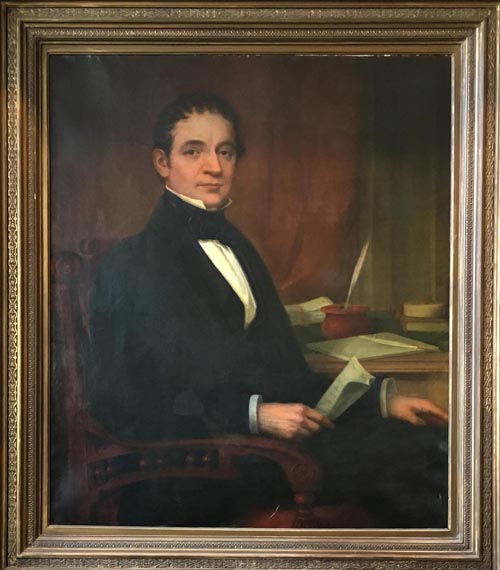Silas Bronson
(1788-1867)

Thanks to a profoundly generous private donation, Waterbury’s public library was founded in 1868. A wealthy New York City merchant, Silas Bronson, left $200,000 in his will to the City of Waterbury for the creation of a public library. This was an enormous sum of money in that time period, equivalent to tens of millions of dollars today.
Although he had lived in New York City for decades, Bronson was originally from Waterbury, growing up on his family’s farm on Breakneck Hill (now part of Middlebury, but at the time part of Waterbury). Born in 1788, Bronson had only a limited grammar school education and, after four years of working as a carpenter, moved to Georgia to pursue greater opportunities as a merchant. After fifteen years in Georgia, Bronson relocated to New York City in 1830, setting up a business importing and selling textiles and related goods to retailers. By the 1850s, Bronson had retired from the import business and focused on commission work.
During the 1830s, Bronson lived next to his older brother, Isaac, on Park Place in Manhattan. Isaac Bronson was a surgeon during the Revolutionary War, after which he became a banker, associating closely with Alexander Hamilton, the first U.S. Secretary of the Treasury. Isaac was one of the nation’s first investors, trading in U.S. government securities. He eventually became one of the chief money lenders in New York City and, in 1828, was one of the eleven wealthiest New Yorkers. Isaac and his wife, Anna, spent half the year in New York and half the year in Fairfield (their Connecticut estate is now Fairfield Country Day School).
In an 1845 directory of Wealthy Citizens of New York, Isaac Bronson’s estate was valued at $2.5 million, making him one of only two dozen millionaires in New York City; the wealthiest, John Jacob Astor, was worth $25 million. Silas Bronson, by then a retired merchant, was worth $150,000 – significantly less than his brother’s estate, but still a considerable amount of money at that time. Silas was able to grow his small fortune through investments, primarily through New York State bonds. Toward the end of his life, he served as a Director of the American Exchange National Bank of New York, alongside another Waterbury-born businessman, David Hoadley (son of the architect of the same name). By the time of Silas Bronson’s death in 1867, he was worth more than a million dollars.
Bronson was a lifelong bachelor. With no family to care for, or to care for him, later in life he maintained apartments in New York City’s best hotels. From 1853 until his death, Bronson lived at the St. Nicholas Hotel on Broadway. The St. Nicholas, which opened in 1853, was the premiere hotel in New York City, the first to cost more than $1 million to construct, with gleaming white marble floors, ceiling frescoes, and ornate chandeliers. As a permanent resident of the hotel, Bronson was able to enjoy the latest innovations—gas lighting, dumbwaiters, central heating, flush toilets, hot water, and steam-powered washing and drying machines in the laundry.
Bronson’s will left much of his fortune to his nieces and nephews, as well as $25,000 to the New York City Hospital. Influenced by his friend, Matthew Vassar, who left $350,000 to found Vassar women’s college, Silas Bronson bequeathed $200,000 to the City of Waterbury for the creation of a public library, making education available for all. Bronson’s will specified that the library bequest was “for the promotion of the education and intelligence and general information of the inhabitants of the City of Waterbury.”
Bronson’s bequest became the start of the Bronson Library Fund and was, at the time, the largest library fund in the state. The revenue generated from its investment was enough to cover the library’s operations for decades. The Silas Bronson Library, named for its founding benefactor, opened on April 1, 1870 with a collection of 11,500 books.
Return to Library History Page